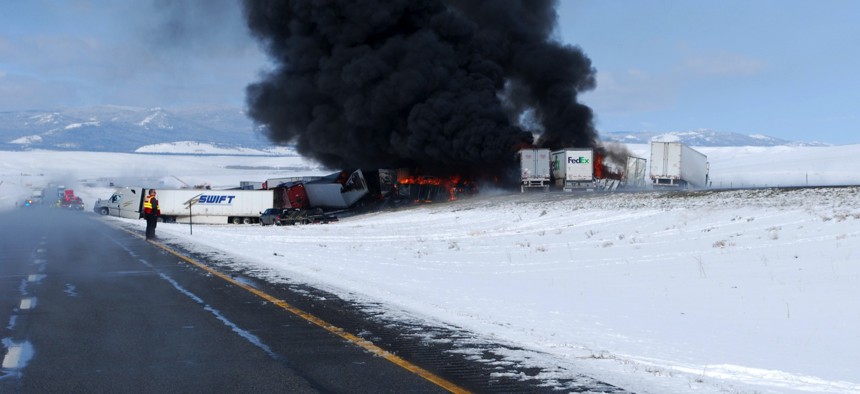Connecting state and local government leaders
The state’s DOT hopes advanced communications will gather and distribute better information about hazards on Interstate 80, especially in winter.
The snow was falling hard, the visibility was poor and the road was undoubtedly slick as the trucks came barrelling down Interstate 80, one after another. Each of them tried to stop, but it was too late. A few of the drivers were able to slow down or veer onto the roadside, but most of the rigs slammed directly into the pile of already-wrecked semis blocking the highway.
This crash happened on the morning of April 16, 2015, about 15 miles west of Cheyenne, Wyoming. More than 45 vehicles were involved, and 27 people were injured, six of them seriously or critically, according to the Wyoming Department of Transportation . Nobody died.
Bystander videos posted online capture parts of the wreck as it unfolds.
As each truck crashes, the explosive sound of the impact mixes eerily with bursts of wind. There’s other footage that documents the aftermath: semi van trailers crumpled and sheared in half, truck cabs ripped from their chassis. A Toyota Prius partly crushed.
Less than a week later, on the morning of April 20, a similar incident occurred on Interstate 80, about 18 miles west of Laramie, Wyoming.
With dense fog in the air, and light slush on the road, two tractor trailers collided and jackknifed blocking the highway’s westbound lanes. This triggered a pile-up with 64 vehicles, many of them tractor trailers, according to Wyoming’s DOT. A truck carrying a hazardous chemical solvent, Butyl Cellosolve, burst into flames. Two people died and at least 20 were injured.
“When there’s blowing snow events, which are fairly common, unfortunately we can have a single vehicle make a mistake that results in multi-vehicle crashes, possibly fatalities and long-term closures,” Vince Garcia, the program manager for intelligent transportation systems at the Wyoming Department of Transportation, said during a recent phone interview.
Preventing these types of wrecks along Interstate 80 is a big part of what has motivated a new pilot program the state’s transportation department is now developing, which will involve the installation of emerging, wireless communications technology in semi trucks.
The so-called “connected vehicle” technology is expected to become increasingly common on U.S. highways in the coming years. Various forms of it allow trucks and cars to “talk” to one another, and nearby infrastructure, by exchanging data in near-real-time about things such as a vehicle’s braking, speed, weight, direction and location.
Advocates of the technology say it has the potential to help prevent collisions, cut down on road congestion and enable drivers and traffic managers to make better decisions.
‘An Impact on Every Driver’
Interstate 80, a major east-west corridor for truck freight in the United States, can be treacherous in winter. In Wyoming, the road reaches a high point of of 8,640 feet between Cheyenne and Laramie at Sherman Summit. Dangers on the highway include snow, ice, fog and high winds, with gusts so forceful they can knock a full-sized semi truck over onto its side.
Only a small fraction of the trucks traveling on Interstate 80 will be outfitted with advanced communications equipment through the new pilot program in Wyoming. But there are plans to have the equipped vehicles transmit data about road conditions, as they travel down the highway, which would be sent to the state’s Transportation Management Center .
The idea is to use this data to improve the accuracy and timeliness of the road condition updates that are accessible to all drivers traveling on the highway.
Located in Cheyenne, the Transportation Management Center is staffed 24 hours-a-day, year-round. Along with other duties, staff there provide motorists, truckers, and trucking companies with highway condition updates via text messages, email alerts, a 511 call-in phone line and a website—which, according to Garcia, had over 700 million visits last winter.
“It will take some time for the connected vehicle technology to get into trucks,” said Ali Ragan, a project manager with Wyoming DOT. “Even if we can’t give the information directly to the driver, we plan to improve some of our other existing condition-reporting systems, to be able to give better information, more tailored information, to commercial vehicle operators.”
So, for instance, a truck outfitted with connected vehicle equipment, traveling across Interstate 80 in Wyoming, might transmit data to the Transportation Management Center in Cheyenne, which indicates where highway conditions are poor. The center could then interpret this data, and update the information it provides accordingly. A dispatcher at a trucking company, who then sees that update, could relay it to their drivers who are out on the highway.
Getting “vehicle dynamics” from the trucks equipped with the new connected vehicle technology is one hope with the pilot program, Garcia explained. “We’ll be able to grab stuff like windshield wipers, and identify that means, maybe, there’s an intensity of rainfall, or hard braking that might indicate what the surface conditions are, that sort of thing” he said.
Ragan sees potentially broad benefits. “Really, it’s going to have an impact on every driver on the road,” she said. “We hope to make the road safer for everybody.”
Speed and Wind Warnings
Funding for Wyoming’s initiative was awarded last fall through the U.S. Department of Transportation’s Connected Vehicle Pilot Deployment Program . The Transportation Department is providing the state with about $730,000 for the first phase of its pilot, which is now underway. Costs are expected to total around $5.2 million, according to information the Wyoming DOT issued last year. On Jan. 19, Wyoming’s DOT submitted a document known as a “ concept of operations ,” to the Transportation Department, marking a significant, but early step for the program. The document offers a description of how the state plans to carry out the pilot.
While many of the specifics of the program are not nailed down, Ragan highlighted a few key areas the it will focus on.
One is “speed harmonization,” which means providing information to truckers and other motorists traveling on Interstate 80 about what traffic ahead of them is doing—stopping or slowing down for example—in order to give drivers more time to adjust their own speed.
A trucker who gets that kind of information early enough might have a better shot at avoiding a pile-up like the ones that took place on the highway last year.
Garcia likens it to a rolling variable speed limit system. Wyoming has variable speed limits in effect on Interstate 80. These are posted on electronic signs and can be changed based on factors including road and weather conditions.
How truckers would see warnings about the speed of vehicles ahead of them remains uncertain. One possibility is that these warnings could be displayed on the screens of GPS units.
It was also not immediately clear what type of wireless technology would be used to deliver messages to the rigs, or if and when in-cab warnings that are produced as part of the pilot would be available to trucks that are not outfitted with equipment through the program.
Garcia and Ragan said the pilot would certainly involve some form of “ dedicated short range communications ” technology, commonly referred to as DSRC. A radio form of wireless technology, DSRC is widely expected to provide the foundation for vehicle-to-vehicle and vehicle-to-infrastructure communication systems in the coming years.
“That is a requirement, we do have to have a DSRC component to this pilot,” Garcia said.
Most trucks on the road today are not equipped with DSRC equipment.
As part of the pilot program, Garcia and Ragan said it is possible that information could get exchanged using other types of systems as well, such as those that rely on cellular technology.
Wyoming has floated plans to equip a number of state vehicles, including snow plows, and some rigs from private trucking fleets, with connected vehicle equipment as part of the pilot. Although a couple of commercial trucking firms have volunteered to participate in the program, the total number of vehicles that will eventually be equipped is still not known, Garcia said.
The state’s DOT has conducted stakeholder meetings about the pilot, which included representatives from the trucking industry. One concern that came up was that any messages that do get displayed in truck cabs should not be overly distracting.
Any in-cab messaging system that gets used would likely undergo testing to see how drivers react to it using a vehicle simulator at the University of Wyoming, Ragan said.
Providing improved warnings to truckers about strong winds, she said, is another major objective of the pilot program. More than 200 truck “blowovers” were reported in Wyoming between 2011 and last fall, according to the state’s DOT.
Additional areas the pilot will seek to cover include developing ways to alert drivers about construction zones and low bridges, and providing information about where truck parking is available, so that truckers don’t park in unsafe places along the interstate.
‘Trying to Look at What the User Needs’
Wyoming DOT deliberately held off meeting with vendors while it drafted the concept of operations document.
“We kept them at a little bit of arm’s length,” Garcia said. “We’re trying to make sure that we’re not designing a system based on what the available technology is.” Instead, he said, “we’re trying to look at what the user needs.” Referring to the award for the pilot program, he added: “As soon as it was announced, we started getting phone calls from vendors.”
In February, Garcia said, representatives from the state’s department of transportation are planning to visit a test facility to see equipment demonstrated that could be used as part of the pilot.
Trucks outfitted with equipment through the program could be on the road as early this fall, Garcia and Ragan said. But that timeframe, they emphasized, is not locked down.
Two cities were also awarded funding last fall through the connected vehicle pilot program— New York City and Tampa, Florida. New York has plans to install vehicle-to-vehicle communications systems on 10,000 city-owned vehicles, including buses, to help alleviate road congestion. And Tampa will be looking to improve pedestrian safety by equipping people’s smartphones with connected technology, similar to what will be put into vehicles.
When it comes to what Wyoming is trying to achieve, Garcia put it this way: “Safety and mobility is really the crux of it for us.”
Bill Lucia is a Reporter for Government Executive’s Route Fifty.

NEXT STORY: Vermont State Workers Duped in Tax-Season Phishing Scam




